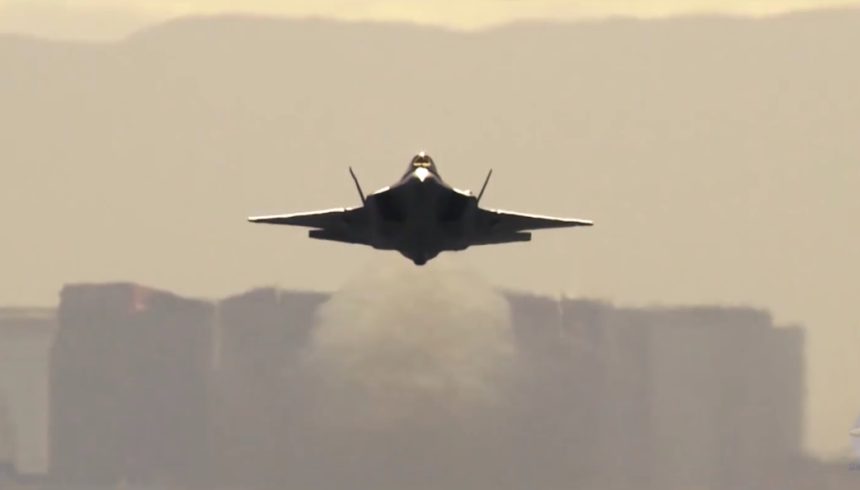Looks like the F-35 achieved an impressive 20:1 kill ratio at Nellis Air Force Base’s Red Flag 17-1
Every aviation enthusiast knows about Red Flag, the large-scale aerial combat training exercises held four times per year at Nevada’s Nellis AFB just north of Las Vegas.
The historical highlight of the recent Red Flag 17-1 was the very first inclusion of the U.S. Air Force F-35A Lightning II in the exercise. F-35As of the 388th and 419th Fighter Wing at Hill AFB, Utah, launched large multi-aircraft sorties during Red Flag 17-1.
Three words summarize the role of the F-35A during this Red Flag exercise; stealth, integration and flexibility. To a greater degree than any previous aircraft in U.S. Air Force history the F-35A Lightning IIs from Hill AFB acted as sensors, guidance platforms and strike assets almost simultaneously, and they did so in a threat environment that would have been previously impenetrable without significantly greater loses. They also performed in an air-to-air role: although we don’t know the ROE (Rules of Engagement) in place for the drills nor the exact role played by the F-22 Raptors that teamed up with the Lightning II throughout the exercise, the results achieved by the F-35, appear to be impressive, especially considering the 5th Gen. aircraft’s additional tasking during RF.
Indeed, while early reports suggested a 15-1 kill ratio recent Air Force testimony by Lt. Gen. Jerry D. Harris, Vice Commander of Air Combat Command characterized the kill ratio as “20-1” meaning that, for one F-35A “lost” in simulated combat in a high threat environment that the aircraft destroyed 20 simulated enemy aircraft.
During the same testimony, U.S. Marine Lt. Gen. Jon M. Davis, Deputy Commandant for Aviation, related a 24-0 kill ratio for U.S. Marine F-35B aircraft during a different exercise.
Whereas the air superiority scenario has not been disclosed (therefore, the above mentioned kill ratio should be taken with a grain of salt, as always when it deals with mock air-to-air engagements…), other details of the F-35As specific missions during the exercise are beginning to emerge from Red Flag 17-1.
The recently revealed reports suggest that large-scale F-35A strikes were conducted in a highly contested/denied aerial environment. Air Force F-35As penetrated denied airspace and directed standoff weapons from B-1B heavy bombers flying outside the denied airspace. Those strikes destroyed simulated surface to air weapons systems. This suggests some of the exercises were an example of a “first day of war” scenario where Air Force F-35As spearheaded an attack on a heavily defended target set both in the air and on the ground. The F-35As entered the denied airspace and engaged both aerial and ground targets, not only with weapons they carried but also with weapons launched from other platforms such as the B-1Bs as they loitered just outside the threat environment acting as “bomb trucks.”
USAF Capt. Tim Six, and F-35A pilots of the 388th Fighter Wing from Hill AFB, alluded to the “Sensor fusion both on-board, and off-board the aircraft” when he discussed the F-35A’s expanding envelope of strike and inter-operable capabilities.
This demonstration of F-35A capabilities counters an ongoing trend in the development of air defense networks for potential western adversaries. To a much greater degree than the F-117A Nighthawk defined the opening hours of the first Gulf War by penetrating Iraqi Air defenses and striking strategic targets with precision and stealth the F-35A expanded on that strike capability during this Red Flag according to the flying branch’s post-exercise statements.
At Red Flag 17-1 the F-35A also included additional roles previously reserved for air superiority aircraft like the F-15C Eagle and heavy strike capability from large bombers while even performing “light AWACS” duties.
“I flew a mission where our four-ship formation of F-35A’s destroyed five surface-to-air threats in a 15-minute period without being targeted once,” Major James Schmidt, an F-35A pilot for the 388th Fighter Wing from Hill AFB told the Air Force Times.
“After almost every mission, we shake our heads and smile, saying ‘We can’t believe we just did that’ Schmidt told reporters.
Major Schmidt went on to highlight the multirole capability of the F-35A in a non-permissive environment when he recalled, “After taking out the ground threats the multirole F-35A is able to pitch back into the fight with air-to-air missiles, taking out aircraft that don’t even know we’re there.”
Another addition to media coming from Red Flag 17-1 is this beautifully done extended video from our friends at Airshow Stuff shows a remarkable array of combat aircraft arriving and departing for air combat exercises. There are B-1B Lancers, F-22 Raptors, EA-18G Growlers, F-16 Aggressors based at Nellis, RAF Typhoons, Australian E-7A Wedgetail Airborne Early Warning and Control aircraft, an Aussie C-130J Hercules transport.
At the 18:51 point in the video we get a ride in a KC-135 tanker for an approach straight into Nellis and a look at what flying into the busy base is like.
Another interesting political implication of Red Flag 17-1 is the inclusion of the Royal Australian Air Force. Although RAAF takes part to RF exercises every now and then, this may suggest an increased tempo of integrating new U.S. assets with other air forces in the Pacific region, possibly as a pro-active response to increased North Korean threats in that region.
Related articles
















